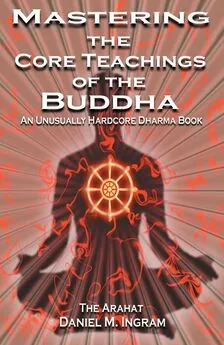Daniel Ingram - Mastering the Core Teachings of Buddha - An Unusually Hardcore Dharma Book
- Название:Mastering the Core Teachings of Buddha - An Unusually Hardcore Dharma Book
- Автор:
- Жанр:
- Издательство:Aeon Books
- Год:2009
- ISBN:9781904658405
- Рейтинг:
- Избранное:Добавить в избранное
-
Отзывы:
-
Ваша оценка:
Daniel Ingram - Mastering the Core Teachings of Buddha - An Unusually Hardcore Dharma Book краткое содержание
Mastering the Core Teachings of Buddha - An Unusually Hardcore Dharma Book - читать онлайн бесплатно полную версию (весь текст целиком)
Интервал:
Закладка:
Some people can get so serious and fixated on suffering that they fight the pleasant raptures and even cling to the difficult ones. Don't do this! The joy and pleasure that may arise in meditation has wonderful healing aspects to it, and it can lead to deep tranquility, concentration and equanimity, which are all really good things. Don't cling to pleasant states either, as you will just get stuck and be frustrated when they end, which they always do. In general, if you try to fight or cling to raptures you will get stuck, and if you can accept them as they are this will be of benefit. See equanimity at the end of this list, as well as the expertly written Chapter 9 of A Path with Heart by Jack Kornfield.
This is a good place for me to mention the concept of vedena, which is a Pali word that relates to the degree of pleasantness, unpleasantness or neutrality of a sensation. If one pays too much exclusive attention to sensations that are either pleasant, unpleasant, or neutral, while ignoring the other sensations going on at that time, then one is likely to be missing many opportunities for insight. Preoccupation 45
The Seven Factors of Enlightenment
with pleasant sensations can cause one to become a vapid bliss-junkie.
Preoccupation with unpleasant sensations can cause one to become dark and depressed. Preoccupation with neutral sensations can cause one to become dull and emotionally flat. (Thanks to the esteemed Christopher Titmuss for the inspiration for this paragraph). Our experience tends to be a complex mixture of many flavors of sensations.
They are all quite worthy of investigation.
The take-home message here is that rapture and raptures are to be understood as they are and related to wisely, accepting all sensations that make them up, be they pleasant, unpleasant, or neutral. Learn when to put the breaks on practice if the difficult raptures are teaching you their important lessons a bit too fast for you to keep it together, and learn how to open to the wonderful joy and bliss which spiritual practice may sometimes produce.
TRANQUILITY
Joy, bliss and rapture can produce tranqu ility . We can associate being peaceful with tranquility. Focusing on tranquility and a more spacious and silent perspective in the face of difficult raptures can help you ride them out, and just sitting silently and observing reality do its thing can be very powerful practice. There are actually whole schools of spiritual practice dedicated to this. Thus, tranquility is a really good thing in meditation. We may think of great spiritual masters being internally tranquil, and while it may or may not be true, there are reasons why we associate tranquility with spirituality. A mind that is not tranquil will have a harder time concentrating and being balanced. It is just as simple as that. Being kind and moral can help with tranquility, as this lessens the harsh thought patterns in our minds.
This does not mean that non-tranquil moments are not “spiritual”
or that we must adopt some sort of restrained and artificial flatness.
Remember, all types of sensations, mind states and actions are valid phenomena for investigation and real expressions of what is going on.
Real tranquility comes from a deep understanding of all of this, but all too often this ideal becomes some sort of dehumanizing exercise in passivity. Real tranquility often comes naturally, though it may be skillfully cultivated as well. Cultivating equanimity of the kind mentioned later is helpful for cultivating tranquility, as is deepening in 46
The Seven Factors of Enlightenment
pure concentration practices, the second spiritual training. Tranquility, concentration and equanimity are intimately related.
CONCENTRATION
Co ncentrati on we have seen twice before, and we will see it again in much more detail in Part III. One of the challenges of deep tranquility is keeping the mind concentrated. This may seem like a direct contradiction to what I have just said, but there may be stages of practice where there can be so much tranquility that the mind can get quite dull and hard to focus. So, just as tranquility is good for concentration and acceptance, too much is similar to not having enough energy. Remember, balance and strengthen, strengthen and balance.
As these are the Seven Factors of Enlightenment, they apply directly to insight practices, training in wisdom. Thus, the concentration being referred to here is a very different kind of concentration than that used for attaining high concentration states. It is called “momentary concentration.” In the context of insight, concentration really means that we are able to very consistently investigate each sensation that arises, one after the other. In this way, we have stability of our ability to investigate, in that it can happen again and again without interruption, but we are not trying to attain stable states or anything else, as we are doing insight practices.
EQUANIMITY
As mentioned before, concentration can produce great stability of mind, and this can lead to equa nimity . Equanimity is that quality of mind that is okay with things, or balanced in the face of anything, even a lack of equanimity. This may sound a bit strange, but it is well worth considering. Equanimity also relates to a lack of struggle even when struggling, to effortlessness even in effort, to peacefulness even when there is not tranquility. When equanimity is really well developed, one is not frightened of being afraid, worried by being concerned, irritated by being irritated, pissed off at being angry, etc. The fundamental nature of the mind is imperturbable and absolutely equanimous; phenomena do not disturb space or even fundamentally disturb themselves from a certain point of view.
47
The Seven Factors of Enlightenment
There are actually whole spiritual traditions that involve just tuning into this basic truth. There can be great value in learning to see the space around things, rather than just being caught up in the things themselves. A useful phrase from one of these traditions is “cultivating space-like meditative equipoise.” The more we habituate this way of being, the more we connect with the truth of our minds.
There are also some really excellent teachings, especially from Zen and Daoism (also spelled Taoism), that relate to this, such as the teachings about no defilements, no enlightenment (or practice is enlightenment), nothing to perfect, no where to go, etc., and checking in with some of these teachings can be very helpful. This is the important counterbalance to spiritual striving and gung-ho practice that can get very future-oriented if done incorrectly. In the end, even if you have all kinds of insights, if you don't have equanimity, you will be beating your head against a wall, and it actually might feel like that or worse.
Once again we are back to knowing this moment just as it is. This
“just as it is” quality is related to mindfulness and also to equanimity. In the end, we have to just accept the truth of our lives, of our minds, of our neuroses, of our defilements, of impermanence, of suffering, and of egolessness. We have to accept this, and this is what they are talking about when they say “just open to it,” “just be with it,” “just let it be,”
“just let it go,” and all of that.
From a pure insight practice point of view, you can’t ever
fundamentally “let go” of anything, so I sometimes wish the popularity of this misleading and indifference-producing admonition would decline, or at least be properly explained. However, if you simply investigate the truth of the Three Characteristics of the sensations that seemed to be a solid thing, you will come to the wondrous realization that reality is continually “letting go” of itself! Thus, “let it go” at its best actually means, “don’t give a bunch of transient sensations an excessive sense of solidity.” It does not mean, “stop feeling or caring,” nor does it mean, “pretend that the noise in your mind is not there.”
If people start with “just open to it” and yet don't develop strong mindfulness, look into the Three Characteristics and gain deep insights, then their practice may be less like meditation and a lot more like psychotherapy, day dreaming, or even self-absorbed, spiritually-48
The Seven Factors of Enlightenment
rationalized, neurotic indulgence in mind noise. It was noticing the high prevalence of this activity and the pervasive and absurd notion that there was no point in trying to get enlightened that largely demolished my vision of being a happy meditation teacher in some mainstream meditation center somewhere.
Psychotherapy, on the other hand, can be a fine undertaking, but it is a completely different endeavor from meditation and falls squarely in the domain of the first training. I do not, however, advocate wallowing in self-absorbed mind noise, and anyone who has been to a small group meeting on a meditation retreat knows what I am talking about. This is what happens when people don’t ground the mind in the object of meditation.
On the other hand, even if you gain all kinds of strong
concentration, look deeply into impermanence, suffering and no-self, but can't just open to these things, can't just let them be, can't accept the sometimes absurd and frightening truths of your experience, then you will likely be stuck in hell until you can, particularly in the higher stages of insight practices.
Reflect on these previous three paragraphs now and often, as many, many errors on the spiritual path come from not understanding the points made therein. Too often there is an imbalance between the first three (mindfulness, investigation, and energy), and the last three (tranquility, concentration and equanimity). The vast majority of aspiring insight meditators are, to be honest, way, way, way too slack about the first three. Just so, some gung-ho meditators get into trouble when they don't cultivate enough acceptance, balance and peace, related to the second three. When people focus only on the middle factor, rapture, they become vapid bliss-junkies. In short, all seven factors are very important.
The order here is important. Start with good technique,
mindfulness, investigation, etc., and work on the others along the way.
In summary, you must have both insights and acceptance, and each perspective can and should help the other along the way. They are actually one and the same.
One last thing about equanimity: its near enemy, its deadening imposter, is indifference. Real equanimity is accepting of the full range 49
The Seven Factors of Enlightenment
of the heart and experience, whereas indifference is dry, flat and heartless. This point is frequently misunderstood. However, being accepting of the full range of the heart doesn't mean always acting on whatever impulse comes up. Act only on the impulses of the heart that seem skillful and kind.
To balance and perfect the Seven Factors of Enlightenment, you guessed it, is sufficient cause for awakening. Thus, checking in from time to time with this little list and seeing how you are doing and what might need some improvement is a good idea, and just having this list in the back of your mind somewhere can be helpful.
It is important to note that only one factor, investigation of the Three Characteristics, separates training in concentration from training in fundamental insight. When purposefully training in concentration, we decide to be mindful of a limited and specific concentration object, such as the breath or even a rarified state of consciousness. We do not, however, investigate the individual sensations that make up that state, as it would break apart under that investigation and produce insights. If we are not looking for ultimate insights at that point in time, then we should avoid investigating that state. However, we do apply energy to stabilize our concentration, and this produces rapture, a characteristic of the early concentration states. We also cultivate concentration very strongly, obviously, and also tranquility and equanimity, which help us stabilize early states and attain to higher ones. Thus, six of the Seven Factors of Enlightenment are cultivated by training in concentration, and it is often recommended as a preliminary training before training in insight for this and other reasons.
Читать дальшеИнтервал:
Закладка:





![Дженнифер Гюнтер - The vagina book. Главная книга для тех, у кого есть этот орган [litres]](/books/1061538/dzhennifer-gyunter-the-vagina-book-glavnaya-kniga-dl.webp)




